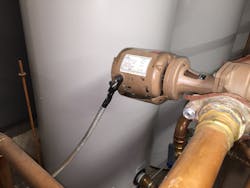How well do you know the Code? Think you can spot violations the original installer either ignored or couldn't identify? Here's your chance to moonlight as an electrical inspector and second-guess someone else's work from the safety of your living room or office. It's your turn to identify the violation.
Hint: on shaky ground
Find the Answer
The first problem I will point out is the fact that the flexible metal conduit (FMC) has become disconnected from the connector and tape was used to try and hold it back together. This is a violation of Sec. 300.10, since metal raceways and enclosures must be metallically joined together to form a continuous electrical conductor. The FMC must also be connected to the fitting and the enclosure in order to provide effective electrical continuity. This lack of continuity creates a violation of Sec. 250.4(A)(5), since there is no longer an effective ground-fault current path. This can greatly increase the risk of shock and fire.
Since motors vibrate, FMC used to connect motors should be provided with an equipment grounding/bonding conductor of the wire type in order to be in compliance with Sec. 250.118(5)(d). This FMC only contains a black and white wire. There is no equipment grounding conductor installed.
Lastly, Sec. 348.30 requires FMC to be secured within 12 in. of each conduit termination. Where flexibility is needed, however, Exception No. 2 allows longer lengths to be unsupported, but since this is 3/8 in. FMC, then Exception No. 2 is not applicable. Therefore, this FMC is not properly supported.
About the Author

Russ LeBlanc
Owner
Russ started in the electrical trade as an apprentice in 1985. He worked his way up to become a Journeyman Electrician and then eventually became a Master Electrician and Licensed Construction Supervisor. In 1999 Russ become an Electrical Instructor for The Peterson School of Engineering in Massachusetts where he developed his passion for teaching, and quickly became Department Head of Electrical Instruction. Russ has taught thousands of apprentices, electricians, engineers, inspectors, and other electrical professionals during his career as an instructor. He continues to provide electrical professionals with Electrical Code seminars, Arc-Flash Awareness training seminars and educational material through his LeBlanc Consulting Services in North Reading, MA whose specialty is educating electricians. He has been an active member of the NFPA Electrical Section and has authored hundreds of National Electrical Code proposals and comments which have become Code rules to improve the safety for the electrical industry. Russ is also an IAEI certified Electrical Inspector.
Please visit www.russleblanc.net for more information.
